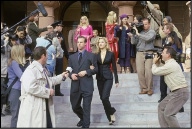|
LEGALLY BLONDE SHINES IN THE CLASSROOM, FALLS FLAT
IN THE COURTROOM
By Michael Asimow
Legally Blonde is a pretty good law school comedy
and a pretty bad courtroom comedy. As summer movie fare goes,
that isn't such a bad average.
Blond bombshell Elle Woods
(the Elle comes from Amanda Chang's clever book title--One Elle)
gets into Harvard Law School on the strength of a smashing 179
LSAT and a 4.0 in fashion merchandising-- plus a dazzling video
(submitted in lieu of the usual essay). She's at Harvard to chase
her former boyfriend and despite the advice of her parents that
lawyers are ugly, boring and serious. She is definitely none
of the above.
 In
what I thought was a hilarious spoof of an Admissions Committee
meeting, the dazzled old fuds on the committee admit Elle in
the diversity category. Then follows an amusing culture clash:
Elle, a Bel Air airhead (who lived across the street from Aaron
Spelling) runs headlong into Cambridge snobbery. Her classmates
can't see anymore than a Malibu Barbie and her professors are
a bunch of bullies and fools. Professor Callahan, apparently
a practicing lawyer in a big firm, is a full professor teaching
first year criminal law at Harvard. He enlists students as free
help on his cases and he sexually harasses Elle. In
what I thought was a hilarious spoof of an Admissions Committee
meeting, the dazzled old fuds on the committee admit Elle in
the diversity category. Then follows an amusing culture clash:
Elle, a Bel Air airhead (who lived across the street from Aaron
Spelling) runs headlong into Cambridge snobbery. Her classmates
can't see anymore than a Malibu Barbie and her professors are
a bunch of bullies and fools. Professor Callahan, apparently
a practicing lawyer in a big firm, is a full professor teaching
first year criminal law at Harvard. He enlists students as free
help on his cases and he sexually harasses Elle.
The law school class scenes
perpetuate the notion that what happens in the classroom is a
bunch of pointless bullying. We learned this from Paper Chase
and it was reinforced in other law school movies--particularly
Just Cause and Soul Man (a thoroughly tasteless
law school comedy which is also pretty funny). In Elle's first
class, she isn't prepared since she didn't know there was an
assignment--and the professor throws her out of the classroom.
This scene was reminiscent of Paper Chase, in which the
same thing happens to Hart who is then abused pitilessly by Kingsfield.
Actually, a better law school teaching scene occurs in The
Pelican Brief--in which a teacher and student engage in a
reasonably productive interchange about an issue of legal policy;
it is spoiled, however, in the next scene when we find teacher
and student in bed together.
The fact is that law school
classes no longer consist of sadistic professors humiliating
helpless students or asking them moronic questions that have
no possible educational utility. Instead, what goes on, more
often than not, is real learning. Dedicated teachers are transmitting
vital analytical skills and debating interesting policy issues
with highly engaged students. True, the classes are too big and
the Socratic method is inefficient, and the intensity level drops
way off after the first year, but the movies never scratch the
surface of what law school is really about or address the real
problems of contemporary legal education. Still, I thought that
the various scenes involving Elle's socialization into law school
ways were pretty funny. Reese Witherspoon carries off the part
with great flair and I, for one, enjoyed it.
But I didn't much like the
courtroom scenes. The bar for courtroom comedies is quite high--My
Cousin Vinny, Bananas, Adam's
Rib, Roxie
Hart, or Mr. Deeds Goes to Town set the standard.
These classic pictures are very funny and they satirize the courtroom
process and the law to great effect. By comparison, Legally
Blonde is strictly bush league. Comedy needs to have a target,
to be about something--it works best when it is most destructive.
The film slices and dices law school and law students with gusto.
Not so in the courtroom scenes.
Here's where Elle joins Callahan's
team of lawyers and law students to work on a murder case. The
client is accused of killing her much older and very wealthy
husband. This part is carelessly written and plotted and the
airhead humor wears thin. At best, it is a pallid takeoff on
the tiresome old Perry Mason routine of finding the killer in
the courtroom.
Elle is the only one of the
legal team to establish rapport with the client (who is her former
aerobics teacher)--that, at least, makes a valid point. She puts
her knowledge of fashion to work by figuring out that a witness
who testifies to an affair with the defendant is really gay because
he knows shoe designers. Not bad.
The client then fires Callahan
and hires Elle, a first year student to head the legal team.
They cite the right rule--Massachusetts Rule of Court 3.03--but
that rule emphatically does not permit a first year student to
represent a wealthy client in a major criminal case (even under
the supervision of a practicing lawyer). Instead, the rule applies
only to senior law students who have taken a course in evidence
or trial practice and are representing the state or an indigent
client. Needless to say, Elle doesn't fit any part of the rule
and is totally clueless in the courtroom. Nevertheless, by incredible
luck she gets the true killer to confess.
So the film is an engaging
bit of piffle with some worthwhile things to say about law school
and eastern snobs, but no good ideas when it comes to the courtroom.
Posted: August 31, 2001
|